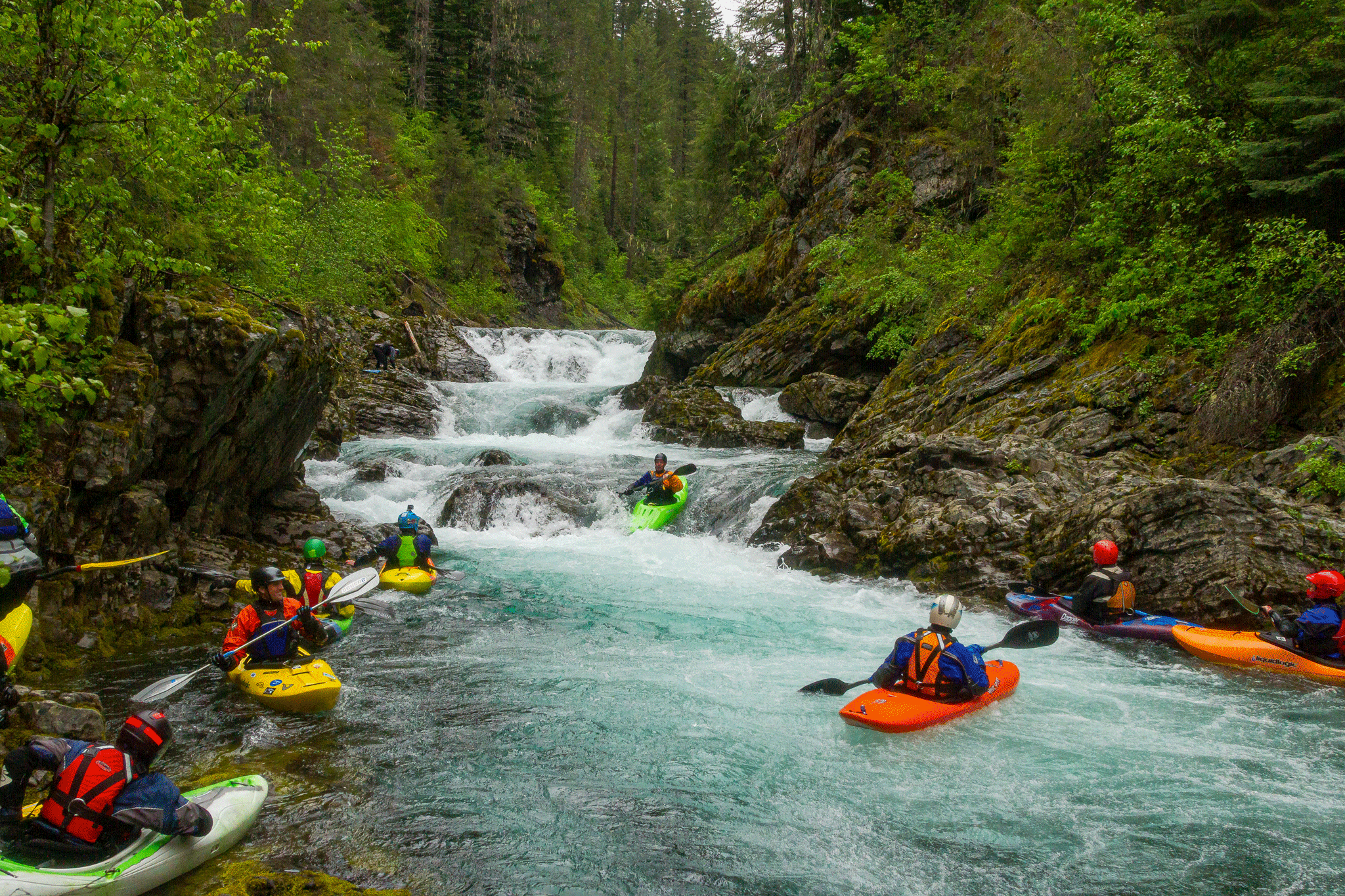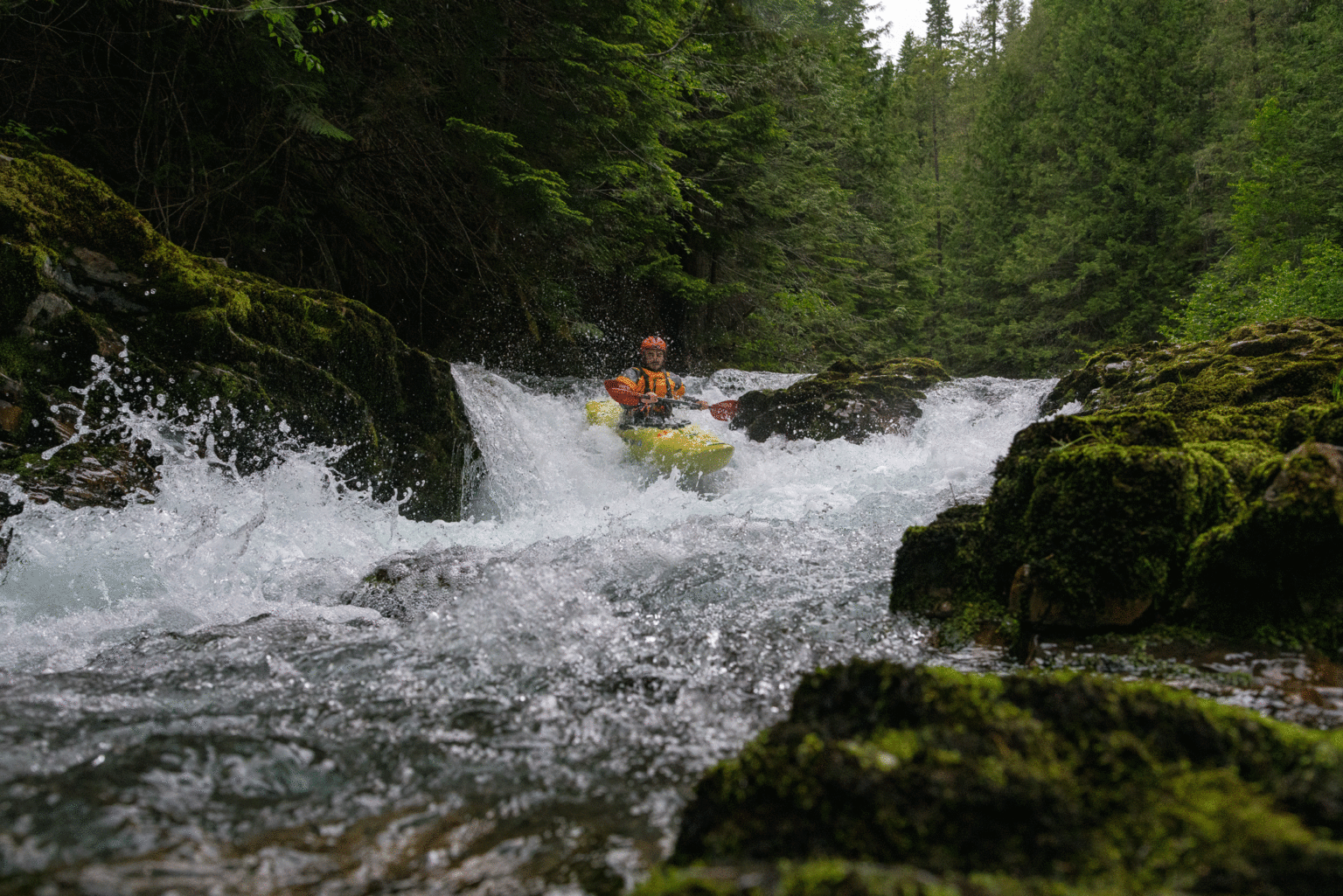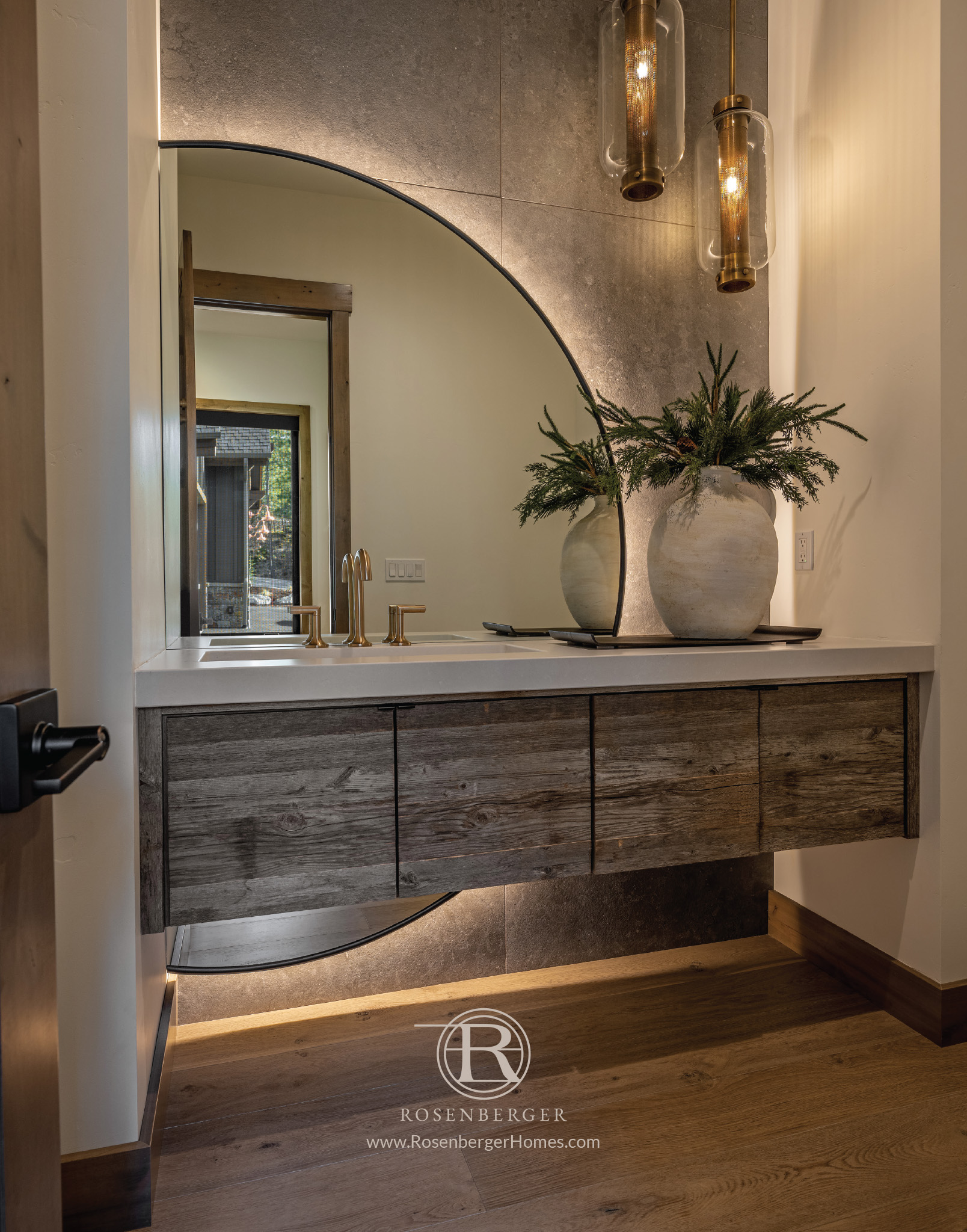Creek Boating in North Idaho
The rushing sound of water fills my ears as I drop my creek boat into a shallow eddy along Slate Creek, a tributary of the St. Joe River.
I quickly stretch out to prevent injury and warm up my muscles while watching a breeze move the ferns and cedar branches along the river.
Positioned just above the first rapid a few yards further downstream, I lower myself into my boat, balancing it carefully so that I don’t end up swimming right off the bat; after all, there will be plenty of opportunity for that downstream.
Pointing upstream in the eddy, I quickly splash snowmelt onto my face. This helps get my mind right and prepares me for the barrage of whitewater that will be hitting me just downstream.
I look over my shoulder and watch as, one by one, my fellow paddlers exit their own eddies and paddle out into the current downstream toward the first rapid of the day on our creek boating adventure.

>> Setting out early
It’s early March, and while technically still winter, paddling season is just beginning. It’s cold and drizzly on the morning we set out. The temperature is just barely above freezing, and first light hasn’t quite chased the moonlight away over the western horizon.
The headlights of my truck illuminate the water standing on the interstate as I make my way east through the darkness toward Wallace, then another 30 or so miles off-road south to Avery where I’ll be meeting some of my closest friends to paddle the local classic, Slate Creek.
I have my creek boat, which is a type of whitewater kayak designed for going down steep, low-volume creeks and rivers, strapped to the roof rack of my truck.
After an hour and a half of motoring deep into the mountains, I pull off St. Joe River Road to the takeout for Slate Creek, which happens to conveniently be at the bridge where the creek pours into the St. Joe. Several folks have already arrived and are huddled out in the rain in the early morning light. We greet each other with handshakes and hugs; it has been a while since we’ve all paddled together.
Story continues after a quick message from our sponsor below.
After catching up, we quickly determine the sometimes-complicated logistics of the shuttle — the goal being to get everyone to the top of the creek in as few vehicles as possible while leaving as many vehicles at the takeout as possible.
Over the next 30 minutes, and 10 very bumpy miles, we finally arrive at the ruins of an old cabin, situated a couple dozen yards from the rugged shoreline of Slate Creek.
We pile out of the truck and grab our equipment and gear. Then we quickly don our dry suits, heave our 50-pound, 9-foot boats up onto our shoulders and wander toward the edge of the creek.
>> Navigating the rapids
Once in the water, I take several paddle strokes, accelerating out of the top of the eddy and edge my kayak downstream; I can feel the power of the river interact with my paddle and boat as I quickly approach the first rapid.
I successfully navigate the first short section of rapids and catch an eddy at the bottom so we can all regroup before tackling the next section. Kevin Pryor, who is running sweep in the rear of the group, gives a quick thumbs indicating everyone is grouped and ready to proceed downstream.
I sometimes find it difficult to focus on the challenges faced when paddling these creeks when surrounded by so much overwhelming beauty. It is hard to go wrong with any creek in North Idaho, but Slate Creek is in a tier of its own. The creek carves itself through a nearly 1,000-foot-deep, heavily forested, and steeply carved canyon. The canyon is filled with large cedars, larches and pines that tower over the creek. Ferns and thick mats of neon green moss cover much of the dark, multi-colored bedrock and scree fields along the creek. My favorite part is the glacial-blue colored water.
After a couple hours and a couple miles of paddling downstream, we arrive at a sizable horizon line, where the river drops about 7 feet over a wide waterfall. This is Bob’s Ledge, and immediately downstream about 100 yards is Horseshoe Falls, the first of two major class 5 rapids of the run.
While Bob’s is only class 4, swimming out of this rapid could have dire consequences due to the nature of the rapids just downstream. Everyone gets out to scout Bob’s and discusses the plan for just downstream at Horseshoe. We unanimously decide to run Bob’s and then rendezvous at the must-make eddy just above Horseshoe. It is imperative no one misses that last eddy as running the falls blind and with no safety could make for a very bad day.
>> Braving the class 5’s
I quickly hop back into my boat, eddy out and take several paddle strokes, making sure to time them correctly so I am pointed straight off the drop. I fly through the air and land in the boil line below Bob’s Ledge. I make several quick paddle strokes to accelerate away from the retentive nature of the feature and paddle downstream to the critical eddy above Horseshoe.
Kevin, Kurt Dobbins and Celine Olgeirsson make their way down next. Josh Heise, Jared Wilcox and Chris Schatz follow. We all make it to the eddy and gather on the shore below. We then wander over to the cliff above Horseshoe Falls.
It is an impressive feature in the river — the entire river chokes down to about 15 feet wide and makes a couple of 3- to 5-foot drops immediately above the main 8-foot drop into a very retentive pool.

We all decide we will paddle hard toward a spine-shaped wave forming over the lip of the Horseshoe Falls. Once the bow crosses that line, a powerful right-hand paddle stroke on the lip of the falls will lift the bow, propel each of us off the falls, through the air, and safely out beyond the worst of the boil line in the pool at the bottom. Deviating from this would likely result in a beat down under the falls.
Jared decides to go first. He’s the youngest and most energetic. He nails it and makes it safely into the final eddy. But as he eddies out and makes his way to the lip, he is slightly offline and takes a left-hand paddle stroke instead of a right. As he flies through the air, his boat turns 90 degrees and he lands sideways in the boil, dangerously close to the plunging waterfall. Miraculously, he manages to paddle away.
Next up is Kurt in his classic smooth style — his years of paddling class 5 creeks on the East Coast shine in these low-volume creeks of the Northwest. He peels out of the last eddy, paddles toward the lip, reaches for the lip, and pulls hard off the falls. He lands perfectly in the pool below with a loud ‘Yeehaw!”
Josh flawlessly executes his line after that, then Chris.
>> The final drop
Once everyone is safely in the pool below, we make our way down another half mile or so to the hardest rapid of the day: the Triple Drop.
Despite what the name implies, Triple Drop is actually a quadruple drop. In a short 75-yard section of the river, the elevation drops about 50 feet over four consecutive drops. We all catch the tiny, must-not-miss eddy above the rapid and get out to scout.
The powerful surging of the water in the pool makes it challenging to decipher where the eddy line and the faster-moving water exiting the pool is. Despite the chaos, I focus on the task at hand. I tune into the boat, my paddle and my body. Almost immediately, I no longer hear the roar of the water. The only point of focus is the 10-foot drop in front of me.
I take several hard paddle strokes and accelerate toward the lip of the drop. As I approach, everything seems to go into slow motion; I edge the boat slightly to the right and reach with my right hand and paddle blade to the lip of the falls. The carbon fiber paddle blade pierces the brilliantly colored water and as soon as I feel the paddle grab, I engage my core muscles and pull hard.
I launch myself off the falls and into the air. Water droplets seem to be suspended in mid-air as I float by them, or maybe they float by me. As I drop, I angle the bow of the boat down and pierce the water with a resounding thud. Water jets over the top of the boat and into my face, temporarily blinding me. Instinctually, I reach forward and take an immediate left paddle stroke to maintain momentum and accelerate away from the falls.
The world seems to speed back up, and I quickly focus on the next steps in the rapid. What seems like an eternity is merely seconds, and I safely make it through the last difficult drop.
We regroup in the bottom eddy, then make our way back down the last half mile of easy whitewater to our trucks at the confluence of the mighty St. Joe, where five hours earlier we started our exciting and adventure-filled day. N
Story and photography by Chris Celentano



